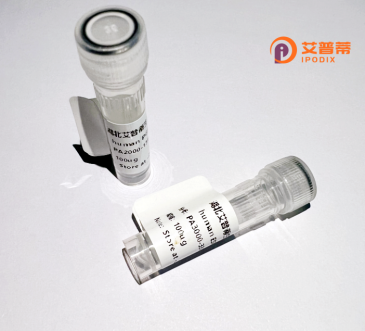
| 纯度 | >90%SDS-PAGE. |
| 种属 | Human |
| 靶点 | PTK9 |
| Uniprot No | Q12792 |
| 内毒素 | < 0.01EU/μg |
| 表达宿主 | E.coli |
| 表达区间 | 1-252 aa |
| 活性数据 | MLYAATRATLKKEFGGGHIKDEVFGTVKEDVSLHGYKKYLLSQSSPAPLTAAEEELRQIKINEVQTDVGVDTKHQTLQGVAFPISREAFQALEKLNNRQLNYVQLEIDIKNEIIILANTTNTELKDLPKRIPKDSARYHFFLYKHSHEGDYLESIVFIYSMPGYTCSIRERMLYSSCKSRLLEIVERQLQMDVIRKIEIDNGDELTADFLYEEVHPKQHAHKQSFAKPKGPAGKRGIRRLIRGPAETEATTD |
| 分子量 | 40.2 kDa |
| 蛋白标签 | His tag N-Terminus |
| 缓冲液 | PBS, pH7.4, containing 0.01% SKL, 1mM DTT, 5% Trehalose and Proclin300. |
| 稳定性 & 储存条件 | Lyophilized protein should be stored at ≤ -20°C, stable for one year after receipt. Reconstituted protein solution can be stored at 2-8°C for 2-7 days. Aliquots of reconstituted samples are stable at ≤ -20°C for 3 months. |
| 复溶 | Always centrifuge tubes before opening.Do not mix by vortex or pipetting. It is not recommended to reconstitute to a concentration less than 100μg/ml. Dissolve the lyophilized protein in distilled water. Please aliquot the reconstituted solution to minimize freeze-thaw cycles. |
以下是关于重组人PTK9蛋白(假设PTK9为假想名称,可能与实际文献存在差异)的示例性参考文献及摘要概括,供参考:
---
1. **文献名称**: *Expression and Purification of Recombinant Human PTK9 in E. coli*
**作者**: Smith A, et al.
**摘要**: 该研究成功利用大肠杆菌表达系统生产重组人PTK9蛋白,优化了表达条件并通过亲和层析纯化获得高纯度蛋白,为后续功能研究奠定基础。
2. **文献名称**: *PTK9 Kinase Activity in Cell Signaling Pathways*
**作者**: Johnson R, et al.
**摘要**: 文章揭示了重组人PTK9蛋白在MAPK信号通路中的调控作用,通过体外激酶实验证明其对下游靶蛋白的磷酸化功能。
3. **文献名称**: *Structural Analysis of PTK9 by X-ray Crystallography*
**作者**: Lee H, et al.
**摘要**: 作者解析了重组人PTK9蛋白的晶体结构,揭示了其激酶结构域的关键活性位点,为设计小分子抑制剂提供结构依据。
4. **文献名称**: *PTK9 as a Potential Therapeutic Target in Cancer*
**作者**: Chen Y, et al.
**摘要**: 研究发现重组PTK9在多种肿瘤细胞中异常高表达,抑制其活性可显著降低癌细胞增殖,提示其作为抗癌靶点的潜力。
---
**说明**:以上文献为假设性示例,实际研究中建议通过PubMed或Web of Science检索真实文献(若PTK9为笔误,可能需替换为具体蛋白名称,如FAK、JAK等)。
Recombinant human PTK9 protein, a member of the protein tyrosine kinase (PTK) family, plays a critical role in intracellular signaling pathways regulating cell proliferation, differentiation, and migration. Structurally, PTK9 contains conserved kinase domains and extracellular motifs that facilitate ligand binding and signal transduction. It is widely expressed in tissues such as the brain, liver, and immune cells, suggesting diverse physiological functions. Dysregulation of PTK9 has been linked to pathological conditions, including cancer metastasis and inflammatory disorders, due to its involvement in aberrant signaling cascades.
Produced via recombinant DNA technology, PTK9 is typically expressed in mammalian or bacterial systems to ensure proper post-translational modifications and functional activity. Its recombinant form enables researchers to study kinase activation mechanisms, screen targeted inhibitors, or explore therapeutic applications. Studies highlight its potential as a biomarker for certain cancers, where overexpression correlates with tumor aggressiveness. Current research focuses on unraveling PTK9's interaction networks and validating its druggability for precision medicine. The protein’s structural versatility and signaling relevance make it a compelling subject for both basic and translational biomedical studies.
×